ASIA PACIFIC STUDIES
Asia Pacific Institute of Advanced Research. East Asian History. East Asia's Geography Through the 5 Themes, 6 Essential Elements, and 18 Geographic Standards. In approaching the complexity of China, Robert W.
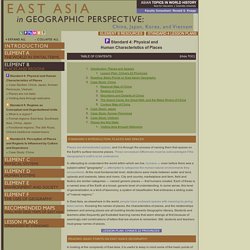
McColl's article Understanding the Geography of China: An Assemblage of Pieces** [Education about Asia] provides the most important information needed to understand the regional subdivisions of China, with useful cues as to how to remember the "pieces" and their relationships to each other.
Columbia University. The World Factbook. People from nearly every country share information with CIA, and new individuals contact us daily.
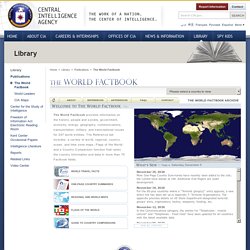
If you have information you think might interest CIA due to our foreign intelligence collection mission, there are many ways to reach us. If you know of an imminent threat to a location inside the U.S., immediately contact your local law enforcement or FBI Field Office. For threats outside the U.S., contact CIA or go to a U.S. Embassy or Consulate and ask for the information to be passed to a U.S. official.
Please know, CIA does not engage in law enforcement. In addition to the options below, individuals contact CIA in a variety of creative ways.
WVS Database. Asian countries. Learn about ADB activities in member countries and regional offices.

Index Mundi - Country Facts. ASEAN Statistics. Resources for East Asian Language and Thought. Asia-Studies Full-Text Online. E-Books » Brill Online - Asian Studies. Print edition: Volume 2, number 2, October 2015 [Asian Review of Books]
A Visual Sourcebook of Chinese Civilization. Association for Asian Studies > Home. CrossAsia: OGEA - Suche. Home – East Asia Integration Studies. AsiaPortal. Nordic Institute of Asian Studies.
International Institute for Asian Studies. Asian Dynamics Initiative – University of Copenhagen. Analyse des personnalités nord-coréennes présentes aux festivités des 70 ans du Parti du Travail Coréen. N’ayant pas fait parti des convives du 70ème anniversaire de la formation du Parti du Travail Coréen (le Parti Communiste nord-coréen), j’ai du me contenter de regarder les 2 heures 171 minutes des festivités via la télévision russe.
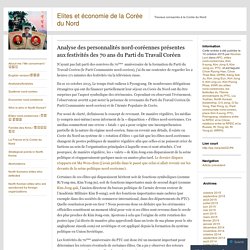
En ce 10 octobre 2015, Le temps était radieux à Pyongyang. De nombreuses délégations étrangères qui ont du financer partiellement leur séjour en Corée du Nord ont du être surprises par l’aspect symbolique des cérémonies. Cependant en observant l’événement, l’observateur avertit a put noter la présence de revenants du Parti du Travail Coréen (le Parti Communiste nord-coréen) et de l’Armée Populaire de Corée. Par souci de clarté, definissons le concept de revenant. De manière régulière, les médias (y compris moi-même) nous informent de la « disparition » d’élites nord-coréennes. Les festivités du 70ème anniversaire du PTC ont donc été un moment important pour déterminer les retours éventuels de certaines élites.
Photographies et commentaires Sur le même thème. Maritime Security in Southeast Asia: U.S., Japanese, Regional, and Industry Strategies. John Bradford, James Manicom, Sheldon W.
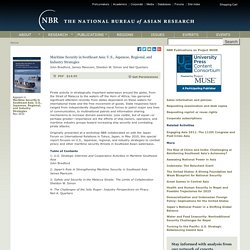
Simon and Neil Quartaro Pirate activity in strategically important waterways around the globe, from the Strait of Malacca to the waters off the Horn of Africa, has garnered significant attention recently from states dependent on these waters for international trade and the free movement of goods. State responses have ranged from independently dispatching naval forces to patrol major sea lines of communication, to multinational patrols and information sharing mechanisms to increase domain awareness. Less visible, but of equal—or perhaps greater—importance are the efforts of ship owners, operators, and maritime industry groups toward increasing ship security and combating pirate attacks. 1: U.S.
Levi McLaughlin, "Komeito’s Soka Gakkai Protesters and Supporters: Religious Motivations for Political Activism in Contemporary Japan", The Asia-Pacific Journal, Vol. 13, Issue. 40, No. 1, October 12, 2015. Recently, adherents of the lay religious organization Soka Gakkai have taken to the streets and the Internet to rebuke Komeito, the junior member of the ruling government coalition and the party founded by Soka Gakkai, for abandoning peace advocacy.
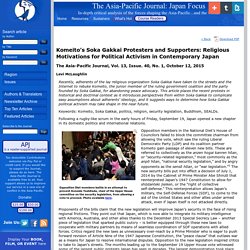
This article places the recent protests in historical and doctrinal context as it introduces perspectives from within Soka Gakkai to complicate easy assumptions about adherents’ ideology, and it suggests ways to determine how Soka Gakkai political activism may take shape in the near future.
Eiichiro Ochiai, "The Human Consequences of the Fukushima Dai-ichi Nuclear Power Plant Accidents", The Asia-Pacific Journal, Vol. 13, Issue. 38, No. 2, September 28, 2015. When a very strong earthquake (magnitude 9.0) hit the Pacific ocean side of the northeastern part of the main island of Japan on March 11th (3.11) 2011, the accompanying huge tsunami wiped out many communities along the coast.

Close to 20,000 people lost their lives, mainly due to the tsunami. Many who were stripped of their homes and livelihood continue to struggle to recover their ways of life. One of the most disastrous results of the quake/tsunami was the devastation at the Fukushima Dai-ichi Nuclear Power Plant (Fk-1) of the Tokyo Electric Power Co (TEPCO).
Street Performers and Society in Urban Japan, 1600-1900: The Beggar's Gift (Hardback) - Routledge.
²bodycard 1160







